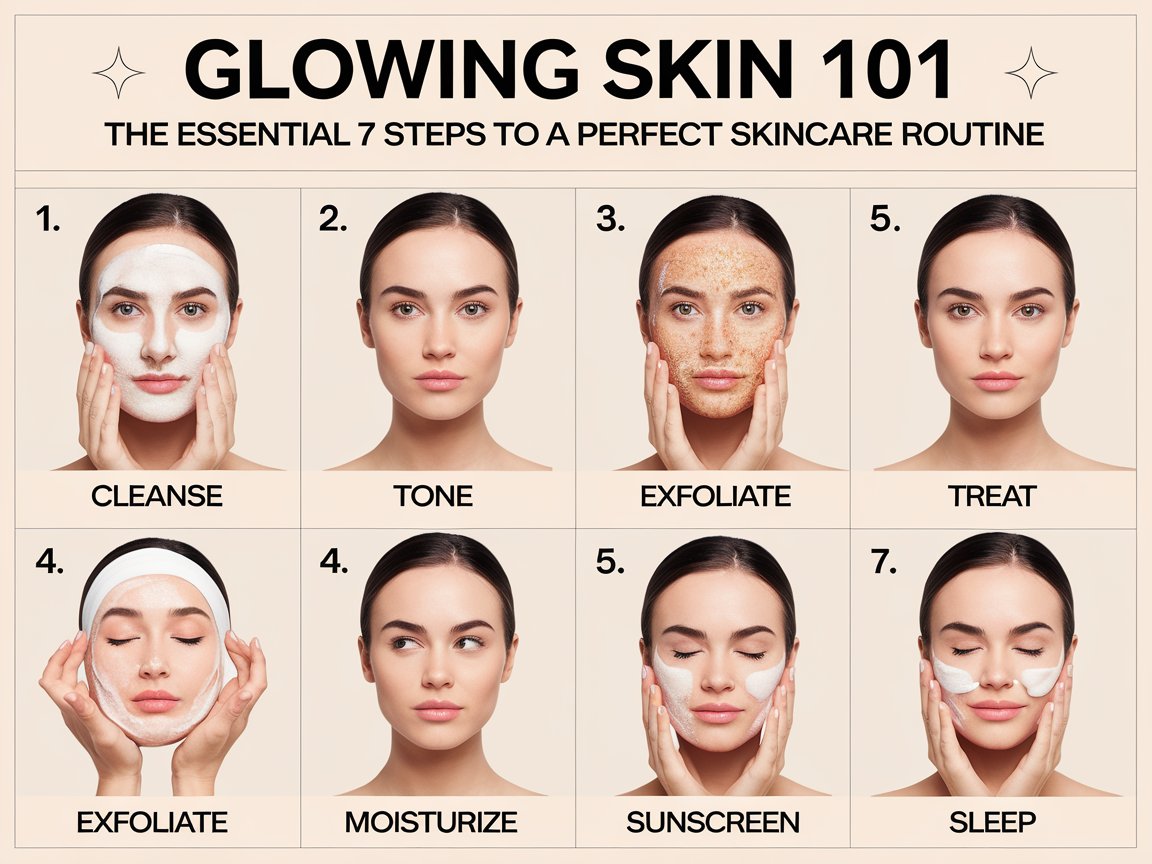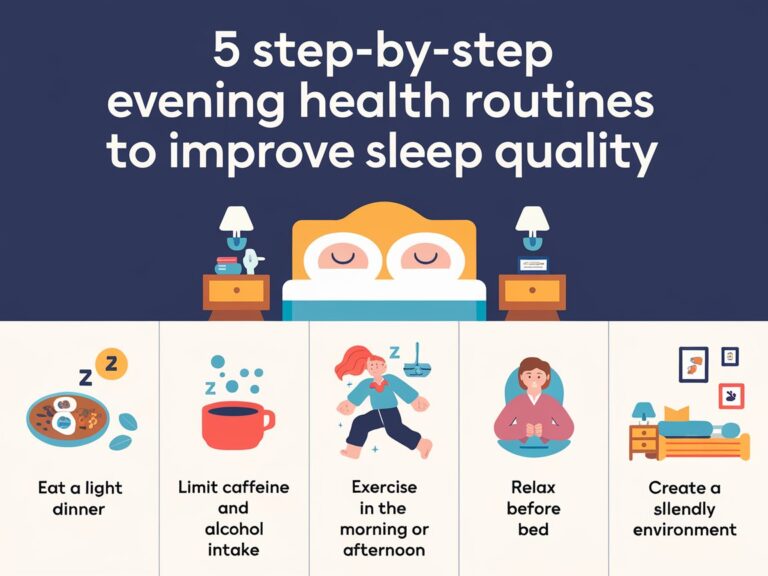Glowing Skin 101: The Essential 7 Steps to a Perfect Skincare Routine
Achieving glowing, radiant skin may feel like a mystery, but it comes down to following the right routine with the right products. A good skincare regimen can do wonders for skin texture, brightness, and overall health. This seven-step guide will break down each essential part of the process, taking you through why it matters, what it does, and how to make the most out of each step. Whether you’re a skincare beginner or someone looking to refine your routine, these steps are the foundation for a healthy, glowing complexion.
Step 1: Cleanser
The first step to any skincare routine is cleansing. Cleansing removes the day’s dirt, oil, makeup, and impurities that settle on your skin and can clog pores, leading to dullness or even breakouts. Choosing the right cleanser for your skin type is essential:
- For oily or acne-prone skin: Gel or foaming cleansers work well as they remove excess oil without stripping the skin.
- For dry or sensitive skin: Opt for cream or oil-based cleansers, which provide a gentle cleanse while maintaining moisture levels.
Tips for Cleansing:
- Wash your face twice a day – once in the morning to refresh and again at night to remove impurities.
- Use lukewarm water to cleanse, as hot water can dry out the skin, and cold water may not effectively remove dirt and oil.
Cleansing sets the stage for your skincare routine by preparing your skin to absorb the next products fully.
Step 2: Exfoliate
Exfoliation is crucial for achieving that glowing skin we all crave. It helps to slough off dead skin cells and boost cell turnover, which keeps your skin looking fresh and radiant. There are two types of exfoliants:
- Physical Exfoliants: Scrubs or brushes that physically remove dead cells. Use gentle, finely milled products to avoid irritation.
- Chemical Exfoliants: Products containing AHAs (alpha hydroxy acids) like glycolic or lactic acid, or BHAs (beta hydroxy acids) like salicylic acid, which dissolve dead skin cells and unclog pores without the abrasive effect of scrubbing.
Frequency:
- Limit exfoliation to 2-3 times a week, especially if you have sensitive skin. Over-exfoliating can damage the skin barrier and lead to redness, dryness, and irritation.
Step 3: Toner
Toning may seem optional, but it plays a vital role in maintaining a balanced and hydrated complexion. Toners can remove any residual impurities left after cleansing, but modern toners do much more. Depending on your skin type, you can choose a toner with hydrating, calming, or exfoliating properties.
- Hydrating toners contain ingredients like hyaluronic acid, which attract moisture to the skin.
- Exfoliating toners with mild AHAs or BHAs gently remove dead cells, refining skin texture.
- Soothing toners with ingredients like chamomile or rose water help calm sensitive or irritated skin.
Tips for Using Toner:
- Apply toner to a cotton pad and gently sweep it across the face and neck or simply pat it in with your hands.
- Allow the toner to absorb fully before moving to the next step.
Toning preps the skin to absorb the following products better and creates a smooth base for any serums or moisturizers.
Step 4: Serum
Serums are powerful, concentrated treatments designed to target specific skin concerns, from dullness and dehydration to fine lines and hyperpigmentation. Since they contain smaller molecules that can penetrate deeper into the skin, serums are incredibly effective for delivering active ingredients.
- For brightness: A vitamin C serum is an excellent choice as it fights free radicals, brightens skin, and improves overall texture.
- For hydration: Hyaluronic acid attracts and retains moisture, leaving skin looking plump and youthful.
- For smoothing and calming: Niacinamide, a form of vitamin B3, helps smooth fine lines, reduce inflammation, and even out skin tone.
Application:
- Apply a few drops to the face and neck, gently pressing the serum into the skin for optimal absorption.
- It’s best to apply serum to slightly damp skin, as this can help with absorption.
Step 5: Eye Cream
The skin around our eyes is thinner and more delicate, which means it often shows signs of aging, stress, and lack of sleep more quickly than other areas. Eye creams are formulated to address these specific concerns, such as puffiness, dark circles, and fine lines.
Key Ingredients:
- Caffeine helps reduce puffiness and dark circles by improving circulation.
- Peptides support collagen production, which helps to reduce fine lines.
- Hyaluronic acid hydrates and plumps the skin to minimize the appearance of fine lines.
Application Tips:
- Use your ring finger to gently tap a small amount of eye cream around the orbital bone. This finger applies the least pressure, which is ideal for the delicate eye area.
Using an eye cream regularly can help maintain a refreshed and youthful look.
Step 6: Moisturizer
Moisturizing is crucial in any skincare routine, no matter your skin type. A good moisturizer locks in hydration, forms a protective barrier on the skin, and prevents moisture loss throughout the day.
- For oily or combination skin: Lightweight, gel-based moisturizers offer hydration without clogging pores.
- For dry or sensitive skin: Thicker creams or lotions provide a more substantial barrier, locking in moisture longer.
Tips:
- Apply moisturizer morning and night to keep your skin consistently hydrated.
- Don’t skip moisturizing even if you have oily skin – maintaining hydration can prevent overproduction of oil.
A well-chosen moisturizer will support the skin barrier and make the skin look and feel smoother and healthier.
Step 7: Sunscreen
Sunscreen is often called the most critical step in any skincare routine. UV rays can cause damage to the skin, leading to premature aging, hyperpigmentation, and an increased risk of skin cancer. Incorporating sunscreen into your daily routine protects against harmful UV rays and preserves all the hard work from the previous steps.
SPF Recommendation:
- Opt for a broad-spectrum sunscreen with at least SPF 30. This protects against both UVA and UVB rays.
Tips for Application:
- Apply a generous amount to the face, neck, and any other exposed areas in the morning.
- Even on cloudy days or while indoors, UV rays can penetrate windows and affect the skin, so make it a daily habit.
Sunscreen is the final and arguably the most vital step, ensuring your skin stays protected and maintains a youthful, healthy appearance over time.
Conclusion
Creating a consistent skincare routine doesn’t have to be complicated or overwhelming. These seven essential steps lay a strong foundation for radiant, glowing skin by providing balanced care, hydration, and protection. Remember, the key to seeing real results is consistency; even the most effective products work best with regular use. Start with these steps and customize as needed to address your skin’s unique needs, and you’ll be on your way to achieving your best skin yet.
By adopting this 7-step routine, you’re not only nourishing your skin but investing in a glowing, healthy future for it as well.



